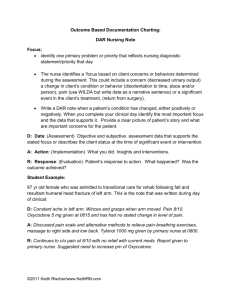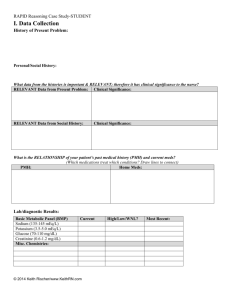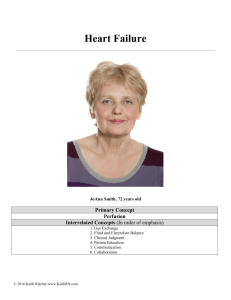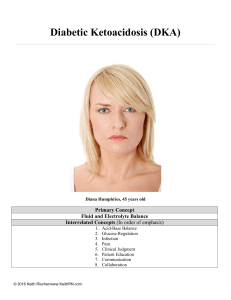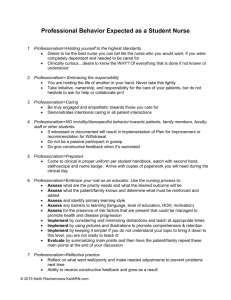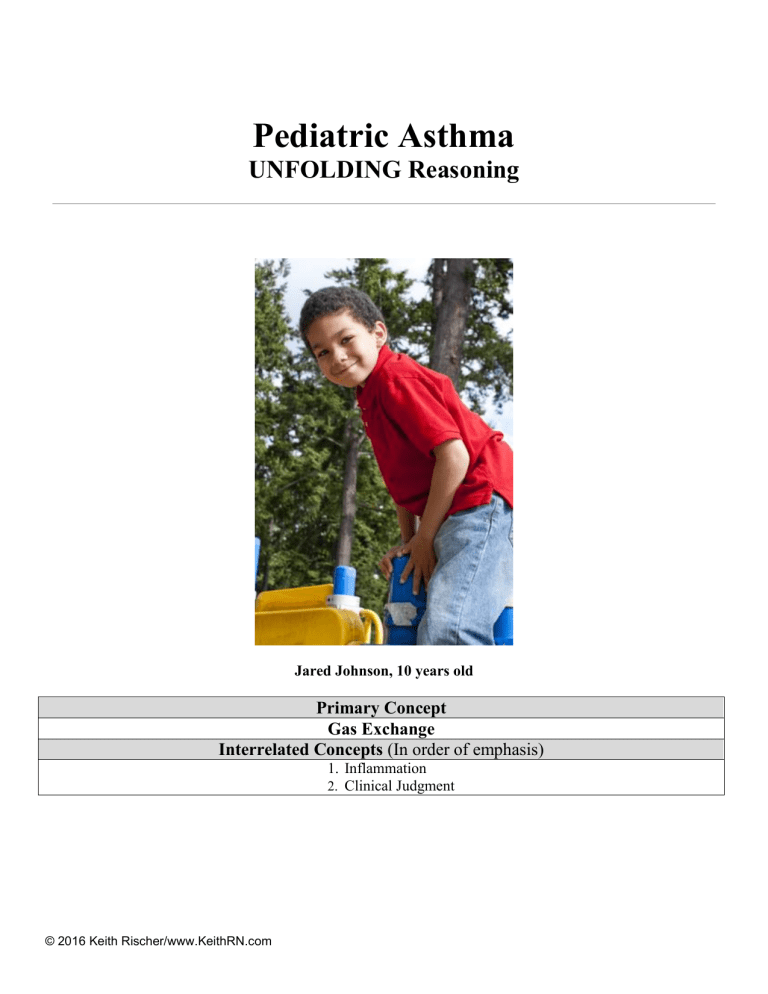
Pediatric Asthma UNFOLDING Reasoning Jared Johnson, 10 years old Primary Concept Gas Exchange Interrelated Concepts (In order of emphasis) 1. Inflammation 2. Clinical Judgment © 2016 Keith Rischer/www.KeithRN.com RAPID Reasoning Case Study: STUDENT Pediatric Asthma History of Present Problem: Jared Johnson is a 10 year-old African-American boy with a history of moderate persistent asthma. He is being admitted to the pediatric unit of the hospital from the walk-in clinic with an acute asthma exacerbation. Jared started complaining of increased chest tightness and shortness of breath one day prior to admission. He has been at 50 percent of his personal best measurement for his peak expiratory flow (PEF) meter reading which did not improve with the use of albuterol metered dose inhaler (MDI) (per his written asthma management plan). In the walk-in clinic Jared is alert, speaking in short sentences due to breathlessness at rest. He has coarse expiratory wheezes throughout both lung fields with decreased breath sounds at the right base. His oxygen saturation on room air is 90%. His color is ashen and he has dark circles under his eyes. He is sitting upright and using his accessory chest muscles to breath and has moderate intercostal and substernal retractions. He is complaining of tightness in his chest. Jared was diagnosed with asthma at age 6 years and has three prior hospitalizations for asthma with one admission to the pediatric intensive care unit. He has never had to be intubated with these episodes. Personal/Social History: He is accompanied by his mother and 16-year-old sister. Jared lives with his mother, maternal grandmother, and sister in an older housing development in the inner city. He is in the 5th grade and a good student despite two to three absences per school year for his asthma. He likes to ride his bike and is the goalie on the soccer team. He says that he has lots of friends at school and likes his teacher, Mr. Bates, who is also his soccer coach. Both Jared and his mother deny tobacco smoke at home. What data from the histories are important and RELEVANT; therefore it has clinical significance to the nurse? RELEVANT Data from Present Problem: Clinical Significance: RELEVANT Data from Social History: Clinical Significance: Patient Care Begins: Current VS: T: 99.9 F/37.7 C (oral) P: 120 (regular) R: 30 (regular) BP: 114/78 O2 sat: 90% on room air End Tidal CO2: 30 P-Q-R-S-T Pain Assessment (5th VS): Provoking/Palliative: Worsens when tries to take a deep breath. Feels better when Quality: Region/Radiation: Severity: Timing: © 2016 Keith Rischer/www.KeithRN.com allowed to sit upright on gurney Tightness Across anterior chest 8/10 Constant What VS data are RELEVANT and must be recognized as clinically significant to the nurse? RELEVANT VS Data: Clinical Significance: Current Assessment: GENERAL Ashen, anxious appearing, moderate respiratory distress. Sitting upright on gurney. APPEARANCE: Only able to talk in short sentences due to breathlessness. Has intercostal and substernal retractions with increased respiratory rate, using accessory muscles to breathe (sternocleidomastoid muscles). RESP: Breath sounds with inspiratory and expiratory wheezing and prolonged expiration. Has tight-sounding non-productive cough, decreased breath sounds in right base CARDIAC: Pale, warm & moist at forehead, no edema, heart sounds regular with no abnormal beats, pulses strong, equal with palpation at radial/pedal/post-tibial landmarks NEURO: Alert & oriented to person, place, time, and situation (x4) GI: Abdomen soft/non-tender, bowel sounds audible per auscultation in all four quadrants GU: Voiding without difficulty, urine clear/yellow SKIN: Skin integrity intact, moist on forehead What assessment data are RELEVANT and must be recognized as clinically significant to the nurse? RELEVANT Assessment Data: Clinical Significance: Cardiac Telemetry Strip: Interpretation: Clinical Significance: © 2016 Keith Rischer/www.KeithRN.com Radiology Reports: What diagnostic results are RELEVANT and must be interpreted as clinically significant by the nurse? RELEVANT Results: Clinical Significance: Chest X-Ray (frontal and lateral views): hyper-expansion of airways with otherwise clear lung fields Lab Results: Complete Blood Count: WBC (4.5–11.0 mm 3) Neutrophil % (42–72) Hgb (12–16 g/dL) Platelets (150-450 x103/µl) Current: 10.0 55 14.1 350 High/Low/WNL? What lab results are RELEVANT and must be recognized as clinically significant by the nurse? RELEVANT Lab(s): Clinical Significance: Basic Metabolic Panel: Sodium (135–145 mEq/L) Potassium (3.5–5.0 mEq/L) Glucose (70–110 mg/dL) Creatinine (0.6–1.2 mg/dL) Current: 138 3.7 80 0.6 High/Low/WNL? What lab results are RELEVANT and must be recognized as clinically significant by the nurse? RELEVANT Lab(s): Clinical Significance: Clinical Reasoning Begins… 1. What is the primary problem your patient is most likely presenting? © 2016 Keith Rischer/www.KeithRN.com 2. What is the underlying cause/pathophysiology of this primary problem? (Relate initial manifestations to the pathophysiology of the primary problem) Pathophysiology of Primary Problem: Rationale for Manifestations: Collaborative Care: Medical Management Care Provider Orders: Vital signs every 1 hour and as needed Rationale: Continuous oxygen saturation monitoring Continuous end tidal CO2 monitoring Start peripheral IV then saline lock O2 to keep saturations >93% Albuterol 2.5 mg and ipratropium bromide 0.25 mg via face mask nebulizer every 20 minutes as needed for respiratory distress Methylprednisolone IV loading dose 2mg/kg then start Methylprednisolone IV 0.5 mg/kg every 6 hours for 48 hours Diet as tolerated © 2016 Keith Rischer/www.KeithRN.com Expected Outcome: PRIORITY Setting: Which Orders Do You Implement First and Why? Care Provider Orders: Oxygen via nasal cannula to keep O2 sat at =/> 93% and place on continuous O2 saturation monitor Obtain vital signs (VS) every hour Albuterol 2.5 mg and ipratropium bromide 0.5 mg inhalation treatments every 20 minutes End tidal CO2 monitoring Establish peripheral IV and give first dose of methylprednisolone Order of Priority: Rationale: Collaborative Care: Nursing 3. What nursing priority (ies) will guide your plan of care? (if more than one-list in order of PRIORITY) 4. What interventions will you initiate based on this priority? Nursing Interventions: Rationale: 5. Expected Outcome: What body system(s) will you assess most thoroughly based on the primary/priority concern? 6. What is the worst possible/most likely complication to anticipate? 7. What nursing assessments will identify this complication EARLY if it develops? 8. What nursing interventions will you initiate if this complication develops? © 2016 Keith Rischer/www.KeithRN.com 9. If the worst possible/most likely complication was recognized by the nurse, when would you decide to notify rapid response team to evaluate further? 10. What psychosocial needs will this patient and/or family likely have that will need to be addressed? 11. How can the nurse address these psychosocial needs? Caring and the “Art” of Nursing 1. What is the patient likely experiencing/feeling right now in this situation? 2. What can you do to engage yourself with this patient’s experience, and show that he/she matter to you as a person? Use Reflection to THINK Like a Nurse Reflection-IN-action (Tanner, 2006) is the nurse’s ability to accurately interpret the patient’s response to an intervention in the moment as the events are unfolding to make a correct clinical judgment. 1. What did I learn from this scenario? 2. How can I use what has been learned from this scenario to improve patient care in the future? © 2016 Keith Rischer/www.KeithRN.com
